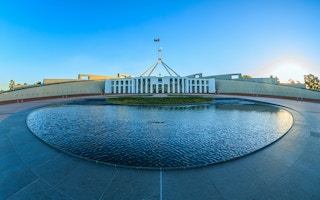There’s a deafening silence in the ongoing Australian election campaign over the environment. Polling shows increasing public support for greater action on climate change but debate has been mostly missing.
And despite some blows traded over the Great Barrier Reef, the wider environment has made almost no appearance. But this hasn’t always been the case.
From the origins of the environmental movement in the 1970s to the 2007 climate change election that toppled Liberal prime minister John Howard, the environment has been a key battleground, and it could become one again.
Green origins
The environment first emerged as a voting platform in the 1970s, in the wake of controversial proposals to dam Lake Pedder. The United Tasmania Group - a precursor to the Australian Greens party - was formed to oppose the project.
Were it not for the mysterious disappearance of a plane carrying environmental activist Brenda Hean in September 1972, the election that brought us Labor prime minister Gough Whitlam might have had more of a green tinge. Hean’s plan was to sky-write “Save Lake Pedder” over Canberra.
According to Hugh Morgan - former president of the Minerals Council, the Business Council, and the climate-denying Lavoisier Group - the first indication that environmentalism had arrived as a major political force in Australia was the Whitlam Labor Party caucus’s 1975 debate over uranium mining and nuclear power.
But it was not until the 1983 election, with incumbent Liberal prime minister Malcolm Fraser facing off against Labor leader Bob Hawke, that the environment became politically salient with another Tasmanian dam.
After losing the Lake Pedder battle in 1972, the green campaigners were older, wiser and more determined in their fight to stop the Franklin dam.
Fraser offered the Tasmanian government a A$500m coal-fired power station instead of the dam, but was rejected.
Labor said it would use federal powers to forbid the dam if elected. It did so, and won the inevitable High Court case.
Hawke and Paul Keating, prime minister from 1991, prioritised financial and political changes (bringing down tariffs, floating the dollar) over environmental challenges. However, the issues of logging and uranium wouldn’t go away, and were joined first by ozone and then carbon dioxide.
In 1984, with a tight election looming, Hawke failed to make the Queensland government’s refusal to nominate forests for World Heritage listing an issue.
Labor won the 1987 and 1990 elections, and environmentalists’ preferences helped them squeak home on both occasions. Climate change hardly rated a mention.
Conned by greenies?
With their rising power, both sides of politics initially courted green voters. But this tactic quickly fell out of favour, first with the Liberals and then with Labor. In 1992 the Greens, despairing of being able to influence either of the big parties, formed their own.
By late 1992, Keating was lashing out at green groups, saying:
…the green movement was extremist and not listened to any more … The environmental lobbies have no moral lien over the environment. The issue belongs to the Government, to the nation.
It’s perhaps unsurprising then that, according to a source of scholar Joan Staples, Keating reportedly walked into an election planning meeting and announced that “the environment will NOT be one of the priority issues in this election.”
“
What is striking about the history of climate change and federal politics is just how quiet politicians become once they get into campaign mode and face scrutiny for the specifics of their policy proposals.
A “bomb” planted on a railway line in northwest Tasmania two days before the 1993 federal election suggested otherwise (it didn’t have a detonator). While media and politician accused “ecoterrorists”; Bob Brown suggested at the time and since that it was a setup to thwart public favour for the Greens.
Nothing changed under the next three year’s of Keating’s government. Another source of Joan Staples recalled that when Keating met green groups before the 1996 election, he walked into the meeting room and pointed at each representative, saying: “Don’t like you. Don’t like you. Don’t know who you are. Don’t like you. She’s alright.”
Despite climbing greenhouse emissions and international pressure on Australia, the environment didn’t feature in the 1998 or 2001 elections, and made only a small but perhaps crucial appearance in 2004 around forestry.
The greatest moral challenge
Liberal prime minister John Howard was unable to ignore the environment three years later. Upon becoming opposition leader in late 2006, Kevin Rudd made climate change not just an issue but “the greatest moral challenge of our generation”.
Howard, who had already tried to keep climate change in a box by reaching for the nuclear option, the Asia Pacific Partnership for Clean Development and Climate and even emissions trading, had no effective reply.
The 2007 federal election, at which Howard became only the second sitting prime minster to lose his seat, has been called, with some justification, “the first climate change election”.
Despite the blood and ink spilt over climate change, it was strangely absent from the 2010 campaign, from which Labor prime minister Julia Gillard eventually emerged victorious. As Laura Tingle has said “it [climate change] wasn’t really something that ever really featured … it just wasn’t there”.
In truth, Gillard had floated a much-derided Citizen’s Assembly ahead of the election. Three years later, despite opposition leader Tony Abbott proclaiming the 2013 poll as a carbon tax referendum, researcher Myra Gurney has found climate change actually rated surprisingly few mentions.
Why the silence?
Besides international positions on climate change, there are any number of local environmental flashpoints that could blow up any day – the Carmichael mine, fracking in New South Wales, or something currently regarded as trivial.
“The environment” has been around as political issue for more than 30 years, and isn’t going to go away, as the environmental and social stresses grow, and the institutional responses lead to “creative self-destruction”.
No doubt both parties will fall over themselves to spruik their support for renewable energy, which is akin to motherhood and apple pie.
What is striking about the history of climate change and federal politics is just how quiet politicians become once they get into campaign mode and face scrutiny for the specifics of their policy proposals.
Perhaps they simply have no answers to awkward questions of what we do to replace our fossil fuel infrastructure and the power of the fossil fuel lobby.
![]()
Marc Hudson, is a PhD candidate, Sustainable Consumption Institute, University of Manchester. This article was originally published on The Conversation.


















